Choosing a Gaming CPU: Single + Multi-GPU at 1440p, April 2013
by Ian Cutress on May 8, 2013 10:00 AM ESTCivilization V
A game that has plagued my testing over the past twelve months is Civilization V. Being on the older 12.3 Catalyst drivers were somewhat of a nightmare, giving no scaling, and as a result I dropped it from my test suite after only a couple of reviews. With the later drivers used for this review, the situation has improved but only slightly, as you will see below. Civilization V seems to run into a scaling bottleneck very early on, and any additional GPU allocation only causes worse performance.
Our Civilization V testing uses Ryan’s GPU benchmark test all wrapped up in a neat batch file. We test at 1440p, and report the average frame rate of a 5 minute test.
One 7970
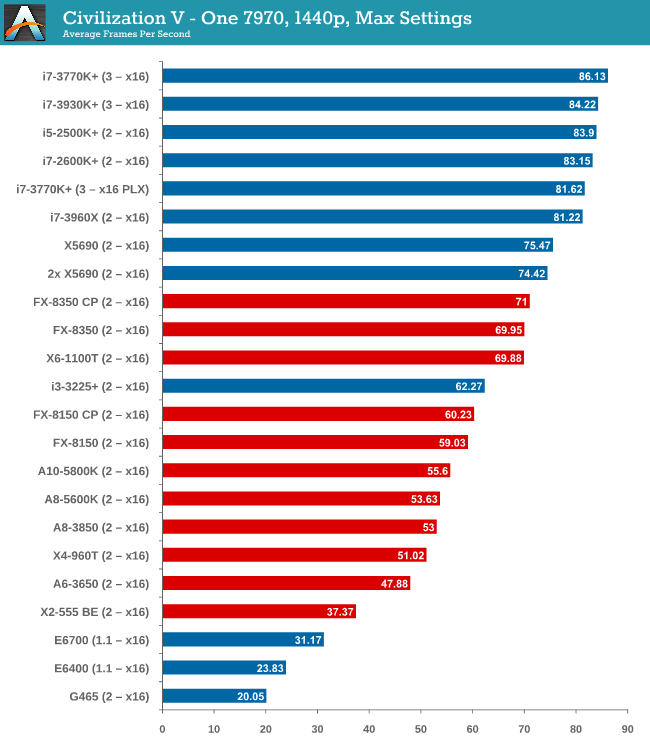
Civilization V is the first game where we see a gap when comparing processor families. A big part of what makes Civ5 perform at the best rates seems to be PCIe 3.0, followed by CPU performance – our PCIe 2.0 Intel processors are a little behind the PCIe 3.0 models. By virtue of not having a PCIe 3.0 AMD motherboard in for testing, the bad rap falls on AMD until PCIe 3.0 becomes part of their main game.
Two 7970s
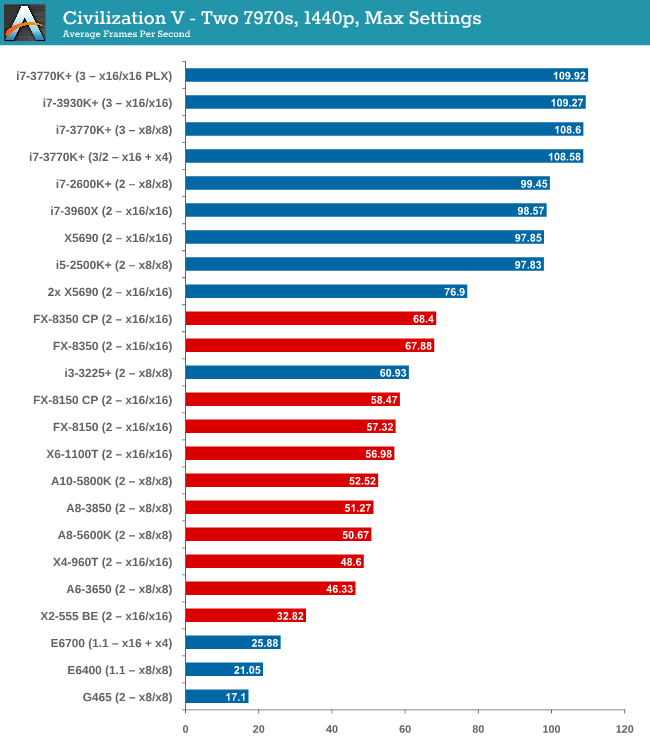
The power of PCIe 3.0 is more apparent with two 7970 GPUs, however it is worth noting that only processors such as the i5-2500K and above have actually improved their performance with the second GPU. Everything else stays relatively similar.
Three 7970s

More cores and PCIe 3.0 are winners here, but no GPU configuration has scaled above two GPUs.
Four 7970s
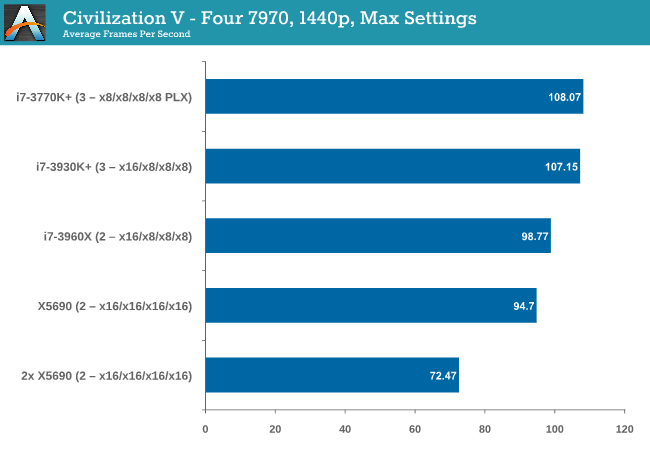
Again, no scaling.
One 580
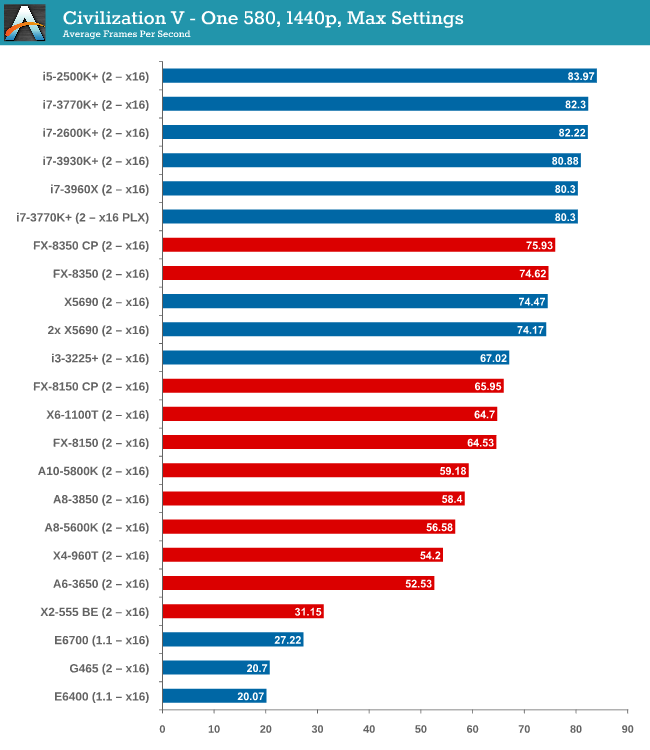
While the top end Intel processors again take the lead, an interesting point is that now we have all PCIe 2.0 values for comparison, the non-hyper threaded 2500K takes the top spot, 10% higher than the FX-8350.
Two 580s
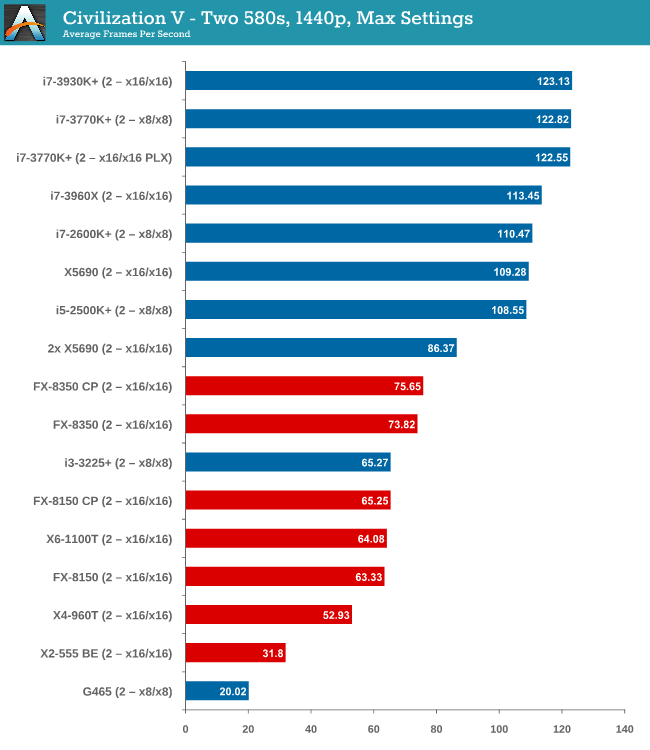
We have another Intel/AMD split, by virtue of the fact that none of the AMD processors scaled above the first GPU. On the Intel side, you need at least an i5-2500K to see scaling, similar to what we saw with the 7970s.
Civilization V conclusion
Intel processors are the clear winner here, though not one stands out over the other. Having PCIe 3.0 seems to be the positive point for Civilization V, but in most cases scaling is still out of the window unless you have a monster machine under your belt.










242 Comments
View All Comments
aburhinox - Wednesday, May 8, 2013 - link
This is a great article to compare cpus across multiple gpus. I'd also be curious to see how different GPUs scale. I'd like to see if a single $400 card is better than 2 $200 cards. I'm going to say that given the choice between one or two $400 cards, two is better than one. Going to the extreme would get you to ask if you want to go crazy, if four $100 cards is better than 1 $400 card. That would probably be going too far since you have to end up with expensive motherboards to support four gpus. But I think that would make a useful article about gpus.dwatterworth - Wednesday, May 8, 2013 - link
Thank you for putting the DP Xeon platform in. I imagine it is a niche market but a platform parallel to that in an older generation would be a huge help. I have an aging LGA 771 Asus Z7S-WS board with (2) e5472 procs with (1) 7950 w/boost. The system was built for 3D rendering and architectural work and as 2 systems are not affordable, this became my gaming machine as well. Other than putting my own benchmarks up against what I can find here or other sites it is very hard for me to decide when and to what to upgrade. I greatly appreciate the Xeon inclusion on this as there are some (few?) who fall into the work + play on a single machine scenario.xinthius - Wednesday, May 8, 2013 - link
You, my friend, just made me laugh well and truly, thank you."his intelligence will diminish gradually." Speaking from experience I see?
kyuu - Wednesday, May 8, 2013 - link
Maybe this is a dumb question, but shouldn't the Core Parking updates also be beneficial to the APUs? They're still using the same module architecture as the FX chips.IanCutress - Wednesday, May 8, 2013 - link
That's planned for the next update, after Haswell launch. At the time I completely forgot and went on to the next platform. Need to pull out the FM2 test bed, install an OS and retest them - another day of testing at least (!). But it's on the 'to do' list.Ian
kyuu - Wednesday, May 8, 2013 - link
Cool, thanks for the reply Ian.antonyt - Wednesday, May 8, 2013 - link
This analysis is great! And extremely useful for anyone contemplating a gaming build in the near future (as I am). I look forward to seeing your updates and more articles like this.Btw, minor typo ("future") at the very end--"but we hope on expanding this in the fuiture."
IanCutress - Wednesday, May 8, 2013 - link
Fixed the typo, cheers :)felang - Wednesday, May 8, 2013 - link
Only if you plan to play single player games onlyxinthius - Wednesday, May 8, 2013 - link
You agree with the fact your intelligence has diminished? Okay.I would LOVE to see you design a microprocessor as complex as one of AMDs. Their processors actually perform admirably in highly threaded workloads, while their current architecture is weak in the IPC department. Their CPUs are by no means weak and should still be recommend in some circumstances, such as their APU range. Please try and post intelligently, I know it's hard for you.